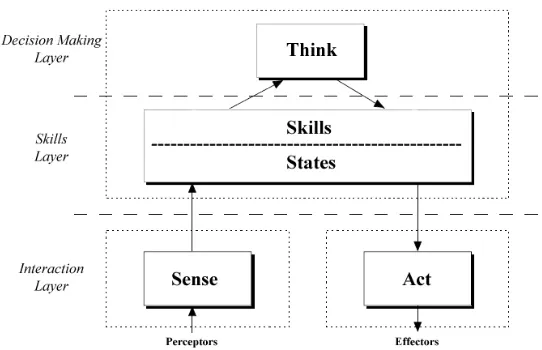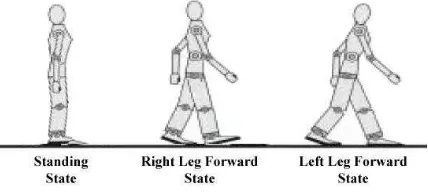UI-AI3D 2007 Research Proposal
Saeid Akhavan, Mohammad Babaeizadeh, Hamid Reza Hasani, Arefeh Kazemi, Hoda Safaeipour, Mohammad Sheykholeslam,
Hedayat Vatankhah, Zahra Zojaji, and Zainab Zolaktaf http://eng.ui.ac.ir/uisim
Computer Engineering Department, University of Isfahan, 81745 Isfahan, Iran
Abstract. The new 3D soccer simulation server, necessitated funda-mental changes in the design of UI-AI team’s architecture. Although this variation does not imply a deviation from the team’s previous expe-riences in Portugal, Japan and Germany, a new hierarchy for the agent structure is inevitable. The UI-AI2007 3D soccer team is designed with a multi-layer architecture. This model, which is based on the most prob-able features of the simulator in Atlanta 2007 competitions, is explained in detail in the following proposal.
1
Introduction
The new 3D environment introduces a more developed aspect of human soccer simulation which results in a better approximation of the reality. This compli-cated environment has proposed a challenging opportunity for specifying the agent’s behavior. In addition to the relatively high level processes that were re-quired in the previous server, new actions such as walking, getting up, running,... must be modeled in terms of body joints movement.As a consequence, the design of a new structure for the agent which takes advantage of all available facilities, especially ones concerning its physical motions, is unavoidable. Since the release of the new server, our main efforts have been concentrated on the design of a structure which satisfies this new, complex environment.
2
Team Architecture
Fig. 1.UI-AI2007 team architecture
2.1 Low Level Layer: Interaction Layer
In order to decrease the complexity of interaction with the server, we were en-forced to hide details from the skill layer as much as possible. This level of ab-straction leads to the implementation of two types of functions, functions that parse incoming messages to extract information provided by preceptors and some simple functions which send messages in order to work with effectors. In other words, interacting with the server is the main job of this layer. This layer is com-pletely implemented and it’s description can be found in the UI-AI2007 agent description.
2.2 Mid Level Layer: States and Skills
Fig. 2.Fuzzy states and transitions
expressed by a set of low level movements which can be implemented using act files described in the agent description paper. These transitions can be optimized using some artificial intelligence methods like reinforcement learning, genetic al-gorithms and etc by considering some parameters like time of transition and the robot’s balance and ZMP point after transition. This kind of optimization can bring us faster and more subtle skills.
Defining states for the purpose of covering the entire possible situations which an agent can move in is a very critical task. Too many states result in unnecessary complexity while a few ones lead to some kind of ambiguity. Thus, in order to
Fig. 3.States of the walking action
2.3 High Level Layer: Decision Making
Finding the best possible action is the main task of this layer. However, this layer is highly dependent on the implemented skills in the lower layers; so the design and implementation of this layer can not start without knowledge about the available skills and their properties. But the mid level layer is a huge task on its own and therefore we may be forced to start working on this layer before having high performance working skills. As a consequence, at some point we may use a set of working but awkward skills like crawling instead of running to build the soccer team; while working on the mid level skills in parallel for the technical challenge competitions. Since the new server is much more complicated than the previous ones, it is not easy to apply well investigated methods in the old simulations here. For example, the offline prediction of opponents’ movement is not possible because each team has its own movement model, and the pre-diction must be done using online methods. Therefore, we will use some kind of abstraction that tries to hide such skills and information from the thinking process and then we will be able to use old techniques to make decisions. Again, fuzzy modeling of the environment and using related fuzzy learning methods seems promising.
3
Conclusion
The main aspect for the UI-AI2007 is to the design and create a working team for the new born generation of 3D soccer simulation server. In addition to the design of the whole team architecture, the low level layer and a simplified version of important actions such as walking and kicking the ball have been implemented, since there was not enough time to implement everything. We tried to design a fuzzy model of the environment by considering all the implemented features of the server and some of the most probable coming ones. Our future works are based on fixing the short comings of the model and implementing the other layers. Because of the complexity of the new 3D server, it seems that the most efforts till Atlanta 2007 will be on the mid level layer in order to make powerful skills.
References
1. Katic D, Vukobratovic M: Control Algorithm for Humanoid Walking Based on Fuzzy Reinforcement Learning.
2. Parseghian A: Control of a Simulated, Three-Dimensional Biped Robot to Initiate Walking, Continue Walking, Rock Side-to-Side, and Balance.
3. Stone P: Layered Learning in Multi-agent Systems.
4. De Boer R, Kok J: The Incremental Development of a Synthetic Multi-Agent Sys-tem: The UvA Trilearn 2001 Robotic Soccer Simulation Team
5. Rutkowska D: Neuro-Fuzzy Architectures and Hybrid Learning
6. Nishiwaki K, et al: Online Generation of humanoid Walking Motion based on a Fast Generation Method of Motion Pattern That Follows Desired ZMP
7. Cuevas E, Zaldivar D, Rojas R: Bipedal Robot Description, Technical Report

